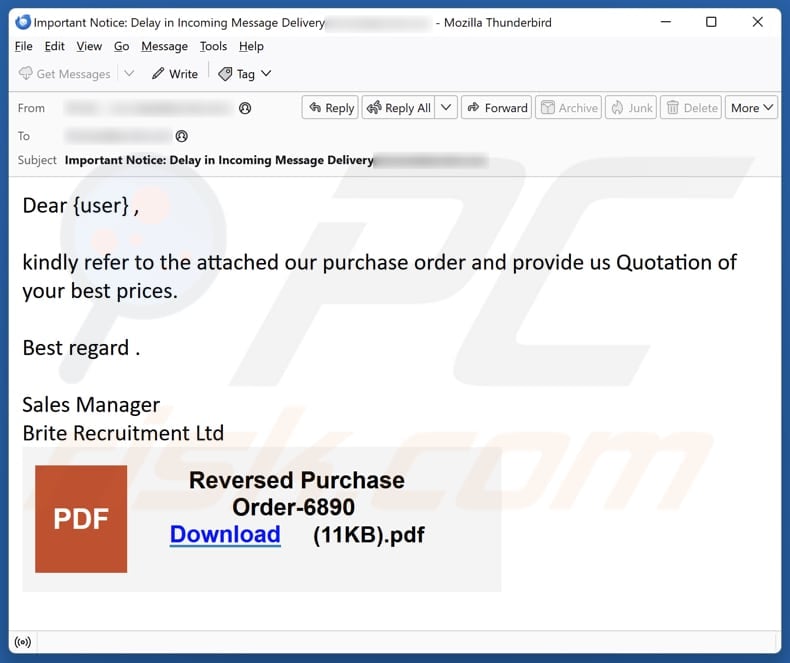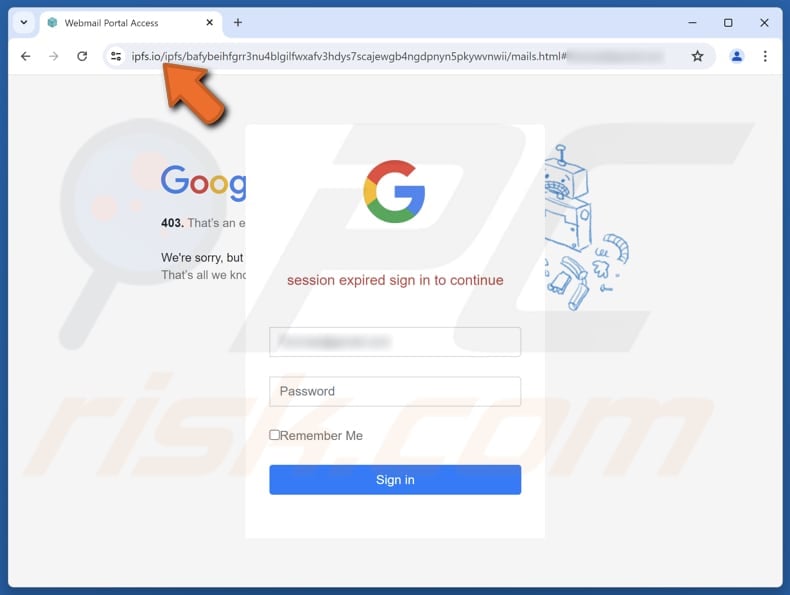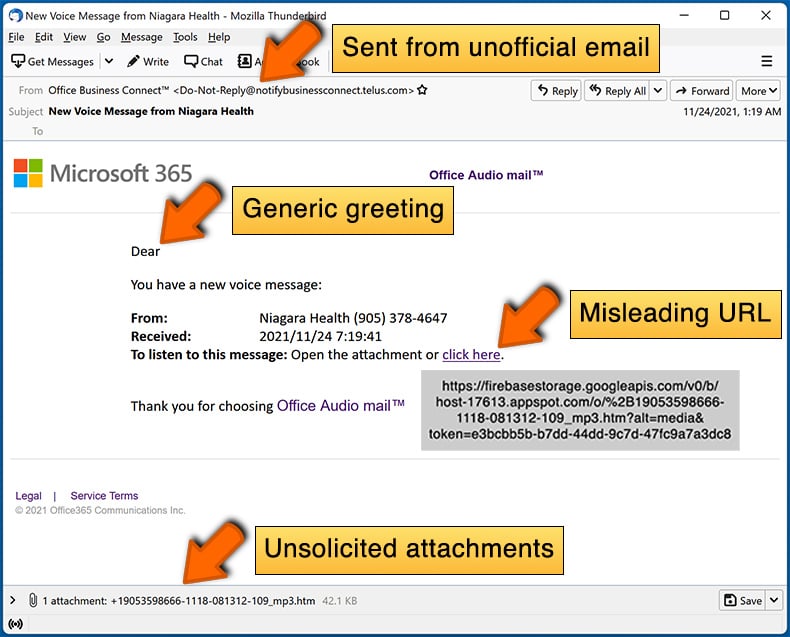How to identify scams like "Purchase Order And Quotation Of Best Price"
Phishing/ScamAlso Known As: Purchase Order And Quotation Of Best Price scam
Get free scan and check if your device is infected.
Remove it nowTo use full-featured product, you have to purchase a license for Combo Cleaner. Seven days free trial available. Combo Cleaner is owned and operated by RCS LT, the parent company of PCRisk.com.
What kind of scam is "Purchase Order And Quotation Of Best Price"?
We have inspected the email and concluded that it is a phishing attempt. This email is crafted to appear as an important notice regarding a purchase order. Its purpose is to extract personal information through a phishing website (a fake login site). Recipients should ignore such emails to avoid potential consequences.

More about the "Purchase Order And Quotation Of Best Price" scam email
The phishing email has the subject "Important Notice: Delay in Incoming Message Delivery". It requests the recipient to refer to the attached purchase order and provide a quotation for the best prices. It seems like a letter from a sales manager in Brite Recruitment Ltd.
Also, the email mentions an attachment titled "PDF Reversed Purchase Order-6890" and includes a "Download" link. Clicking this link opens a fake Google sign-in website claiming that a session has expired and instructing users to sign in using an email address and a password (email account login credentials).
If entered, the login information is sent to scammers, who can use it to access Gmail accounts. With this access, scammers can look for more personal information within emails, send phishing emails, or even distribute malware. They might also try to access social media, banking, or other accounts using the stolen credentials and cause even more harm.
Additionally, scammers can sell the extracted login credentials (and other obtained information) on the dark web. Therefore, it is important to examine emails before providing information or opening attachments or links to avoid identity theft, monetary loss, and other potential issues.
| Name | Purchase Order And Quotation Of Best Price Email Scam |
| Threat Type | Phishing, Scam, Social Engineering, Fraud |
| Fake Claim | The email contains a purchase order |
| Disguise | Request for quotation from Brite Recruitment Ltd. |
| Symptoms | Generic greeting, urgent language, suspicious links, grammatical errors. |
| Distribution methods | Deceptive emails, rogue online pop-up ads, search engine poisoning techniques, misspelled domains. |
| Damage | Loss of sensitive private information, monetary loss, identity theft. |
| Malware Removal (Windows) |
To eliminate possible malware infections, scan your computer with legitimate antivirus software. Our security researchers recommend using Combo Cleaner. Download Combo CleanerTo use full-featured product, you have to purchase a license for Combo Cleaner. 7 days free trial available. Combo Cleaner is owned and operated by RCS LT, the parent company of PCRisk.com. |
Similar scam emails in general
Emails like this one are deceptive messages designed to trick recipients into revealing sensitive information, such as login credentials, credit card details, ID card information, etc. These emails often appear to come from legitimate sources and include urgent requests, misleading links, or attachments.
Falling for such emails can lead not only to data theft but also to computer infections. Examples of deceptive emails are "Funds Disbursed By Presidential Administration", "Account Is Due For Update", and "Emirates NBD - Secure Banking Notification".
How do spam campaigns infect computers?
Cybercriminals deliver malware through email by including infected attachments or fraudulent links. Malware can infiltrate systems after opening these files or performing additional steps like enabling macros in compromised MS Office documents. Threat actors use various files to distribute malware, including PDFs, executables, ISO files, scripts, and compressed files (e.g., ZIP or RAR).
Their emails may also direct users to unsafe websites where malware is automatically downloaded or users are manipulated into installing harmful software by themselves.
How to avoid installation of malware?
Always download software from official websites or trusted app stores. Never download pirated programs, key generators, cracking tools, etc. Keep your operating system and software up to date, and regularly run scans with a reliable security tool. Be careful with unexpected emails from unknown senders, especially those with attachments or links.
Additionally, do not trust advertisements, buttons, links, and pop-ups on questionable sites, and do not permit such web pages to send you notifications. If you have already opened malicious attachments, we recommend running a scan with Combo Cleaner Antivirus for Windows to automatically eliminate infiltrated malware.
Text presented in the "Purchase Order And Quotation Of Best Price" email letter:
Subject: Important Notice: Delay in Incoming Message Delivery
Dear {user} ,
kindly refer to the attached our purchase order and provide us Quotation of your best prices.
Best regard .
Sales Manager
Brite Recruitment Ltd
PDF Reversed Purchase Order-6890(11KB).pdf
Phishing website used in this scam:

Instant automatic malware removal:
Manual threat removal might be a lengthy and complicated process that requires advanced IT skills. Combo Cleaner is a professional automatic malware removal tool that is recommended to get rid of malware. Download it by clicking the button below:
DOWNLOAD Combo CleanerBy downloading any software listed on this website you agree to our Privacy Policy and Terms of Use. To use full-featured product, you have to purchase a license for Combo Cleaner. 7 days free trial available. Combo Cleaner is owned and operated by RCS LT, the parent company of PCRisk.com.
Quick menu:
- What is Purchase Order And Quotation Of Best Price scam?
- Types of malicious emails.
- How to spot a malicious email?
- What to do if you fell for an email scam?
Types of malicious emails:
![]() Phishing Emails
Phishing Emails
Most commonly, cybercriminals use deceptive emails to trick Internet users into giving away their sensitive private information, for example, login information for various online services, email accounts, or online banking information.
Such attacks are called phishing. In a phishing attack, cybercriminals usually send an email message with some popular service logo (for example, Microsoft, DHL, Amazon, Netflix), create urgency (wrong shipping address, expired password, etc.), and place a link which they hope their potential victims will click on.
After clicking the link presented in such email message, victims are redirected to a fake website that looks identical or extremely similar to the original one. Victims are then asked to enter their password, credit card details, or some other information that gets stolen by cybercriminals.
![]() Emails with Malicious Attachments
Emails with Malicious Attachments
Another popular attack vector is email spam with malicious attachments that infect users' computers with malware. Malicious attachments usually carry trojans that are capable of stealing passwords, banking information, and other sensitive information.
In such attacks, cybercriminals' main goal is to trick their potential victims into opening an infected email attachment. To achieve this goal, email messages usually talk about recently received invoices, faxes, or voice messages.
If a potential victim falls for the lure and opens the attachment, their computers get infected, and cybercriminals can collect a lot of sensitive information.
While it's a more complicated method to steal personal information (spam filters and antivirus programs usually detect such attempts), if successful, cybercriminals can get a much wider array of data and can collect information for a long period of time.
![]() Sextortion Emails
Sextortion Emails
This is a type of phishing. In this case, users receive an email claiming that a cybercriminal could access the webcam of the potential victim and has a video recording of one's masturbation.
To get rid of the video, victims are asked to pay a ransom (usually using Bitcoin or another cryptocurrency). Nevertheless, all of these claims are false - users who receive such emails should ignore and delete them.
How to spot a malicious email?
While cyber criminals try to make their lure emails look trustworthy, here are some things that you should look for when trying to spot a phishing email:
- Check the sender's ("from") email address: Hover your mouse over the "from" address and check if it's legitimate. For example, if you received an email from Microsoft, be sure to check if the email address is @microsoft.com and not something suspicious like @m1crosoft.com, @microsfot.com, @account-security-noreply.com, etc.
- Check for generic greetings: If the greeting in the email is "Dear user", "Dear @youremail.com", "Dear valued customer", this should raise suspiciousness. Most commonly, companies call you by your name. Lack of this information could signal a phishing attempt.
- Check the links in the email: Hover your mouse over the link presented in the email, if the link that appears seems suspicious, don't click it. For example, if you received an email from Microsoft and the link in the email shows that it will go to firebasestorage.googleapis.com/v0... you shouldn't trust it. It's best not to click any links in the emails but to visit the company website that sent you the email in the first place.
- Don't blindly trust email attachments: Most commonly, legitimate companies will ask you to log in to their website and to view any documents there; if you received an email with an attachment, it's a good idea to scan it with an antivirus application. Infected email attachments are a common attack vector used by cybercriminals.
To minimise the risk of opening phishing and malicious emails we recommend using Combo Cleaner Antivirus for Windows.
Example of a spam email:

What to do if you fell for an email scam?
- If you clicked on a link in a phishing email and entered your password - be sure to change your password as soon as possible. Usually, cybercriminals collect stolen credentials and then sell them to other groups that use them for malicious purposes. If you change your password in a timely manner, there's a chance that criminals won't have enough time to do any damage.
- If you entered your credit card information - contact your bank as soon as possible and explain the situation. There's a good chance that you will need to cancel your compromised credit card and get a new one.
- If you see any signs of identity theft - you should immediately contact the Federal Trade Commission. This institution will collect information about your situation and create a personal recovery plan.
- If you opened a malicious attachment - your computer is probably infected, you should scan it with a reputable antivirus application. For this purpose, we recommend using Combo Cleaner Antivirus for Windows.
- Help other Internet users - report phishing emails to Anti-Phishing Working Group, FBI’s Internet Crime Complaint Center, National Fraud Information Center and U.S. Department of Justice.
Frequently Asked Questions (FAQ)
Why did I receive this email?
Scammers typically send these emails to numerous people without personalizing them. They often gather email addresses from data breaches, fraudulent websites, or other channels.
I have provided my personal information when tricked by this email, what should I do?
If you have shared personal information (login credentials), change your passwords right away. Additionally, contact your email service provider, especially if you cannot access your account.
I have downloaded and opened a malicious file attached to an email, is my computer infected?
The likelihood of infection depends on the file type. For example, opening an executable file presents a high risk, while the risk is lower with documents. However, malicious MS Office documents can still pose a threat, especially if macros are enabled.
I have read the email but did not open the attachment, is my computer infected?
Opening an email itself is usually safe. The risk of malware infection comes from opening links or attachments.
Will Combo Cleaner remove malware infections that were present in email attachment?
Combo Cleaner can detect and remove most known malware, but more advanced threats might remain hidden deep within your system. For thorough removal, it is recommended to perform a full system scan.
Share:

Tomas Meskauskas
Expert security researcher, professional malware analyst
I am passionate about computer security and technology. I have an experience of over 10 years working in various companies related to computer technical issue solving and Internet security. I have been working as an author and editor for pcrisk.com since 2010. Follow me on Twitter and LinkedIn to stay informed about the latest online security threats.
PCrisk security portal is brought by a company RCS LT.
Joined forces of security researchers help educate computer users about the latest online security threats. More information about the company RCS LT.
Our malware removal guides are free. However, if you want to support us you can send us a donation.
DonatePCrisk security portal is brought by a company RCS LT.
Joined forces of security researchers help educate computer users about the latest online security threats. More information about the company RCS LT.
Our malware removal guides are free. However, if you want to support us you can send us a donation.
Donate
▼ Show Discussion